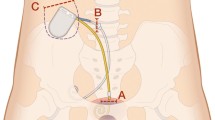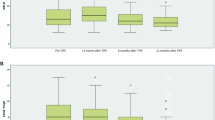Abstract
Introduction
Ascites is a common complication of liver cirrhosis and represents the main cause of hospitalization among patients with cirrhosis. First-line therapy for those patients is the use of diuretics and dietary sodium restriction. However, 10 % of patients per year become therapy refractory to diuretic treatment with the need of repeated high-volume paracentesis or transjugular intrahepatic portosystemic shunt (TIPS). For these patients, an automated pump system (Alfapump/Sequana Medical) was developed. Here, we describe our single-center experience of ten consecutively implanted pump systems.
Patients and methods
Between 08/13 and 11/14, ten Alfapump systems were implanted in patients with refractory ascites all suffering from liver cirrhosis. Those patients were treated as a bridge to transplant (4/10) or as an end-stage therapy (6/10). Median follow-up was 165 days (23–379 days).
Results
Postimplant, the need of paracentesis could be markedly reduced to a mean of 0.45 (0–4/month) per month. In eight patients, paracentesis was not needed after implantation of the pump system. The median daily output volume was 1000 ml/day (450–2000 ml/day). Prerenal insufficiency was a recurrent complication in the postoperative period.
Discussion
The Alfapump system is a useful system in the treatment of patients suffering from therapy refractory ascites. However, due to the high level of comorbidities, careful patient selection and postoperative monitoring are required.




Similar content being viewed by others
References
D’Amico G, Luca A (1997) Natural history. Clinical-haemodynamic correlations. Prediction of the risk of bleeding. Bailliere’s Clin Gastroenterol 11(2):243–256
Gines P, Quintero E, Arroyo V, Teres J, Bruguera M, Rimola A, Caballeria J, Rodes J, Rozman C (1987) Compensated cirrhosis: natural history and prognostic factors. Hepatology 7(1):122–128
Gines P, Cardenas A, Arroyo V, Rodes J (2004) Management of cirrhosis and ascites. N Engl J Med 350(16):1646–1654. doi:10.1056/NEJMra035021
Moore KP, Wong F, Gines P, Bernardi M, Ochs A, Salerno F, Angeli P, Porayko M, Moreau R, Garcia-Tsao G, Jimenez W, Planas R, Arroyo V (2003) The management of ascites in cirrhosis: report on the consensus conference of the International Ascites Club. Hepatology 38(1):258–266. doi:10.1053/jhep.2003.50315
Gerbes AL (1993) Medical treatment of ascites in cirrhosis. J Hepatol 17(Suppl 2):S4–S9
Runyon BA, Practice Guidelines Committee AAftSoLD (2004) Management of adult patients with ascites due to cirrhosis. Hepatology 39(3):841–856. doi:10.1002/hep.20066
Gerbes AL, Sauerbruch T, Dathe K (2011) Method report: German S3-guideline “ascites, spontaneous bacterial peritonitis, hepatorenal syndrome”. Z Gastroenterol 49(6):780–787. doi:10.1055/s-0031-1273404
Arroyo V, Gines P, Gerbes AL, Dudley FJ, Gentilini P, Laffi G, Reynolds TB, Ring-Larsen H, Scholmerich J (1996) Definition and diagnostic criteria of refractory ascites and hepatorenal syndrome in cirrhosis. International Ascites Club. Hepatology 23(1):164–176. doi:10.1002/hep.510230122
Salerno F, Guevara M, Bernardi M, Moreau R, Wong F, Angeli P, Garcia-Tsao G, Lee SS (2010) Refractory ascites: pathogenesis, definition and therapy of a severe complication in patients with cirrhosis. Liver Int 30(7):937–947. doi:10.1111/j.1478-3231.2010.02272.x
Kuiper JJ, van Buuren HR, de Man RA (2007) Ascites in cirrhosis: a review of management and complications. Neth J Med 65(8):283–288
Belghiti J, Durand F (1997) Abdominal wall hernias in the setting of cirrhosis. Semin Liver Dis 17(3):219–226. doi:10.1055/s-2007-1007199
Moore KP, Aithal GP (2006) Guidelines on the management of ascites in cirrhosis. Gut 55(Suppl 6):vi1–vi12. doi:10.1136/gut.2006.099580
Rossle M, Gerbes AL (2010) TIPS for the treatment of refractory ascites, hepatorenal syndrome and hepatic hydrothorax: a critical update. Gut 59(7):988–1000. doi:10.1136/gut.2009.193227
Rossle M, Ochs A, Gulberg V, Siegerstetter V, Holl J, Deibert P, Olschewski M, Reiser M, Gerbes AL (2000) A comparison of paracentesis and transjugular intrahepatic portosystemic shunting in patients with ascites. N Engl J Med 342(23):1701–1707. doi:10.1056/NEJM200006083422303
Smadja C, Franco D (1985) The LeVeen shunt in the elective treatment of intractable ascites in cirrhosis. A prospective study on 140 patients. Ann Surg 201(4):488–493
Martin LG (2012) Percutaneous placement and management of the Denver shunt for portal hypertensive ascites. AJR Am J Roentgenol 199(4):W449–W453. doi:10.2214/AJR.12.9203
Rosemurgy AS, Zervos EE, Clark WC, Thometz DP, Black TJ, Zwiebel BR, Kudryk BT, Grundy LS, Carey LC (2004) TIPS versus peritoneovenous shunt in the treatment of medically intractable ascites: a prospective randomized trial. Ann Surg 239(6):883–889, discussion 889–891
Nitta H, Okamura S, Mizumoto T, Matsushita H, Nishimura T, Shimokawa Y, Kimura M, Baba H (2013) Prognosis assessment of patients with refractory ascites treated with a peritoneovenous shunt. Hepato-Gastroenterology 60(127):1607–1610
Bellot P, Welker MW, Soriano G, von Schaewen M, Appenrodt B, Wiest R, Whittaker S, Tzonev R, Handshiev S, Verslype C, Moench C, Zeuzem S, Sauerbruch T, Guarner C, Schott E, Johnson N, Petrov A, Katzarov K, Nevens F, Zapater P, Such J (2013) Automated low flow pump system for the treatment of refractory ascites: a multi-center safety and efficacy study. J Hepatol 58(5):922–927. doi:10.1016/j.jhep.2012.12.020
Laffi G, La Villa G, Pinzani M, Foschi M, Carloni V, Casini Raggi V, Gentilini P (1993) Refractory ascites: definition, pathogenesis and treatment. Ann Ital Med Int 8(1):38–46
Bernardi M, Caraceni P, Navickis RJ, Wilkes MM (2012) Albumin infusion in patients undergoing large-volume paracentesis: a meta-analysis of randomized trials. Hepatology 55(4):1172–1181. doi:10.1002/hep.24786
Jaurigue MM, Cappell MS (2014) Therapy for alcoholic liver disease. World J Gastroenterol 20(9):2143–2158. doi:10.3748/wjg.v20.i9.2143
Gines P, Uriz J, Calahorra B, Garcia-Tsao G, Kamath PS, Del Arbol LR, Planas R, Bosch J, Arroyo V, Rodes J (2002) Transjugular intrahepatic portosystemic shunting versus paracentesis plus albumin for refractory ascites in cirrhosis. Gastroenterology 123(6):1839–1847. doi:10.1053/gast.2002.37073
Harding V, Fenu E, Medani H, Shaboodien R, Ngan S, Li HK, Burt R, Diamantis N, Tuthill M, Blagden S, Gabra H, Urch CE, Moser S, Agarwal R (2012) Safety, cost-effectiveness and feasibility of daycase paracentesis in the management of malignant ascites with a focus on ovarian cancer. Br J Cancer 107(6):925–930. doi:10.1038/bjc.2012.343
Cardenas A, Arroyo V (2005) Refractory ascites. Dig Dis 23(1):30–38. doi:10.1159/000084723
Moreau R, Delegue P, Pessione F, Hillaire S, Durand F, Lebrec D, Valla DC (2004) Clinical characteristics and outcome of patients with cirrhosis and refractory ascites. Liver Int 24(5):457–464. doi:10.1111/j.1478-3231.2004.0991.x
Guardiola J, Baliellas C, Xiol X, Fernandez Esparrach G, Gines P, Ventura P, Vazquez S (2002) External validation of a prognostic model for predicting survival of cirrhotic patients with refractory ascites. Am J Gastroenterol 97(9):2374–2378. doi:10.1111/j.1572-0241.2002.05928.x
Author information
Authors and Affiliations
Corresponding author
Ethics declarations
Conflicts of interest
None.
Informed consent
Informed consent was obtained from all individual participants.
Ethical approval
All procedures performed in studies involving human participants were in accordance with the ethical standards of the institutional and/or national research committee and with the 1964 Helsinki Declaration and its later amendments or comparable ethical standards.
Rights and permissions
About this article
Cite this article
Thomas, M.N., Sauter, G.H., Gerbes, A.L. et al. Automated low flow pump system for the treatment of refractory ascites: a single-center experience. Langenbecks Arch Surg 400, 979–983 (2015). https://doi.org/10.1007/s00423-015-1356-1
Received:
Accepted:
Published:
Issue Date:
DOI: https://doi.org/10.1007/s00423-015-1356-1




